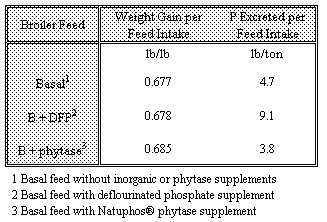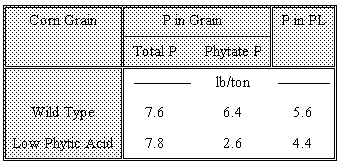
Use of Phytase and Low-Phytate Corn to Increase Phosphorus Availability in Poultry Feed
 |
Use of Phytase and Low-Phytate Corn to Increase Phosphorus Availability in Poultry Feed |
Phosphorus Availability in Poultry Feed
Phosphorus (P) is an essential element in poultry diets for skeletal development, cell structure, and protein, lipid, and energy metabolism. Corn and soybean meal comprise as much as 80% of poultry diets, and more than 60% of P in these ingredients is in the form of phytate, an inositol phosphate molecule. Poultry digestive systems lack the phytase enzyme that breaks down and releases P from phytate. Therefore, only 10% to 30% of P in corn and soybean meal is available to poultry, and forms of inorganic P, such as di-calcium phosphate (CaHPO4), must be added to feed to meet the dietary requirements of poultry. The combination of added inorganic P and unavailable phytate-P results in high concentrations of P passing through poultry during growth and accumulating in poultry litter (PL).
Delaware's poultry industry is vital to the state's economy and agricultural community, with nearly 270 million broiler chickens at an economic value of almost half a billion dollars being produced each year. Virtually all the PL produced by the poultry is land applied as a nutrient source for grain crops, and recent studies show that long-term applications of PL have resulted in P accumulation in many Delaware soils to levels in excess of crop requirements (Sims and Vadas, 1997). There is now serious concern that P may be lost from soils high in P via runoff, erosion, and subsurface drainage and be delivered to surface waters, where it can contribute to eutrophication and associated water quality problems (e.g., algal blooms, fish kills, odors, scums, turbidity, and sedimentation; Sharpley et al., 1994). There is considerable interest in developing agricultural management practices to prevent P accumulations in soils and P transport from soil to surface waters. Increasing the availability of phytate-P in poultry feed can help reduce the quantity of inorganic P that must be added to feed and the quantity of P that ultimately accumulates in PL. This can help reduce the quantity of P that is land applied in PL and prevent the accumulation of P in soils.
Improving Phytate-P Availability with Phytase
Phytate-P must be converted to inorganic P by phytase enzymes before it is available to poultry. Phytase is present in microorganisms, plants, and certain animal tissues. Phytase that is present in poultry digestive tracts can potentially come from four sources: (1) phytase native in digestive secretions, (2) phytase native in feed grains, (3) phytase from bacteria native in poultry or feed grains, or (4) phytase produced by microorganisms and added to feed. The first three phytase sources are negligible for poultry, so to increase phytate-P availability in poultry feed, phytase must be produced by microorganisms and added to feed as a supplement. Research clearly shows that phytase supplementation improves the availability of phytate-P in feed to broiler chickens. Studies have used either Natuphos® (BASF, Ludwigshafen, Germany) or Finase® (Alko Ltd., Rajamaki, Finland). Finase® is now marketed in the Netherlands, Canada, Germany, Switzerland, Austria, Brazil, Norway, and Finland; and Natuphos® was cleared by the FDA for use in the U.S. in November 1995. Yi et al. (1996) showed that adding phytase to soybean and soybean-corn broiler feed decreased P in broiler excreta without affecting broiler weight gain (Table 1).

Table 1. Weight gain and P excretion for broiler chicks fed soybean and soybean-corn
feed as is or supplemented with either inorganic phosphate or phytase enzyme.
Besides P, the phytate molecule may also bind Zn, Cu, Mn, Fe, Mg, Ca, Cr, and proteins and make them unavailable to poultry. Therefore, adding phytase to feed to break down the phytate molecule could also increase the availability of these minerals and proteins, decrease the need to add them as supplements in feed, and reduce their concentrations in PL. This is an important consideration because some U.S. states are now concerned about the build-up of Cu and Zn to phytotoxic levels in soils amended with poultry and swine manure.
Improved Utilization of Phytate-P Using
Low-phytate-P Corn
As much as 85% of P in corn grain is phytate-P. One way to increase the quantity of P in corn that is available to poultry is to reduce the amount of phytate produced by the corn plant. This will decrease phytate-P and increase inorganic P concentrations in grain. Currently, research is being conducted to manipulate the genes in corn controlling phytate formation and decrease phytate-P concentrations in grain. Ertl et al. (1997) have conducted field experiments and feeding trials to investigate the characteristics of corn that produces grain low in phytate-P. They showed that phytate-P concentrations in "low phytic acid" corn grain were as much as 51% less than in "wild type" corn grain (Table 2). Subsequently, P concentrations in the PL of poultry fed the "low phytic acid" grain were 23% less than those in the PL of poultry fed the "wild type" corn grain. Therefore, the use of low-phytate corn in poultry feed can increase the availability of P and other phytate-bound minerals and proteins. Low-phytate corn hybrids are now being tested for adaptability to Delmarva soil and climate conditions and should be commercially available in the near future.

Table 2. Total P and phytate-P concentrations in wild type and low phytic acid corn and
subsequent P concentrations in the litter of poultry fed both types of grain.
Implications and Future Research
The widespread use of microbial phytase and low-phytate corn in poultry feed will depend on the environmental pressures to reduce P and other minerals in poultry wastes and the cost of inorganic P supplements, phytase supplements, and low-phytate corn. Research is still needed on the harvest yields of low-phytate corn, the effect of supplemental phytase and low-phytate corn on the availability of P and other minerals to poultry, and the economic advantages of supplemental phytase and low-phytate corn. Because the PL from poultry produced with low-phytate corn will be land applied, it is also necessary to investigate whether changes in the chemical composition of P in poultry feed will ultimately affect the potential for P to be lost to surface waters from soils amended with low-phytate PL. To ensure the long-term sustainability of both animal-based agriculture and environmental quality, disposal of wastes must be environmentally sound. Specifically in Delaware, developing and utilizing options such as phytase or low-phytate corn can help decrease the potential for poultry-grain agriculture to contribute to the non-point source pollution of valuable surface water resources.
References
Ertl, D.S., K.A. Young, and V Raboy. 1997. Plant genetic approaches to phosphorus management in agricultural production. J. Environ. Qual. (In Press).
Kornegay, E.T. 1996. Nutrient management of food animals to enhance and protect the environment. Lewis Publishers, CRC Press Inc., New York, NY.
Sharpley, A.N., J.T. Sims, T.C. Daniel, R. Wedepohl, and S. Chapra. 1994. Managing agricultural phosphorus for protection of surface waters: Issues and options. J. Environ. Qual. 23:437-541.
Sims, J.T. and P.A. Vadas. 1997. Soil test phosphorus status and trends in Delaware. University of Delaware. Newark, DE. Cooperative Bulletin ST-09.
Yi, Z., E.T. Kornegay, V. Ravindran, and D.M. Denbow. 1996. Improving phytate phosphorus availability in corn and soybean meal for broilers using microbial phytase and calculation of phosphorus equivalency values for phytase. Poultry Sci. 750:240-249.
Click here to close and return to the STP Publications Page